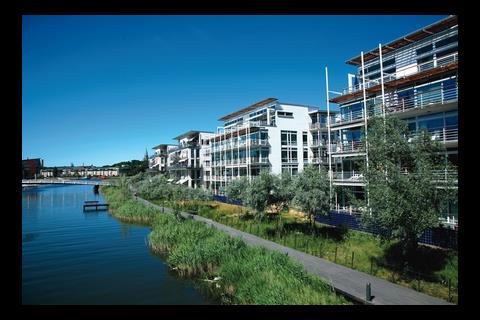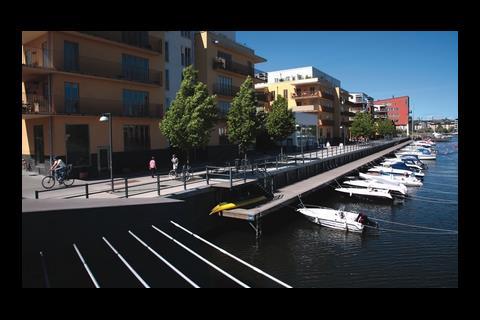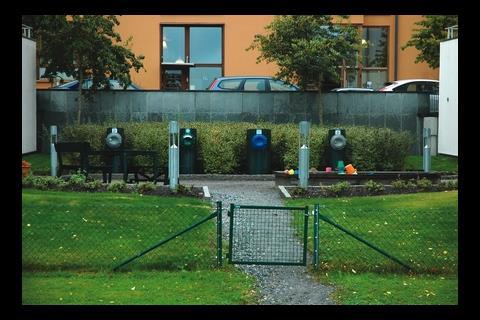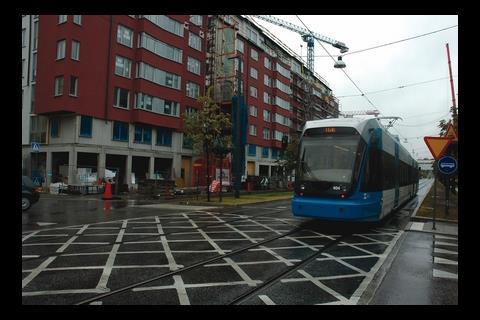This new Stockholm suburb demonstrates how simple, robust, centralised systems can outperform flashy designs bristling with turbines. But can it work as a model for Gordon Brown’s eco-towns?
Summary
- Hammarby Sjöstad is Sweden's version of a sustainable community and has received streams of high profile visitors including housing minister Yvette Cooper
- Target for the suburb is for houses to use half the energy and water than a normal Swedish property
- Waste is collected through a system of tubes manufactured by Envac and burned in a CHP plant
- Swedes believe in providing green heat and power centrally, rathern than adding bolt-on renewables
- Developer Quintain hoping to create a similar model to Hammarby in Greenwich
Main text
For some time now, there has been a steady pilgrimage of the great and the good to an ordinary-looking suburb of Stockholm. The pilgrims included Yvette Cooper, the housing minister and Nicky Gavron, London’s deputy mayor, the chief executives of several councils and housebuilders, as well as sundry developers and architects. The reason they made the journey is that Hammarby Sjöstad is Sweden’s version of a sustainable community – and it couldn’t be more different from the way we do things here if it tried.The focus in the UK is to turn homes into self-sufficient islands by plastering them with expensive renewable technologies and incorporating water recycling at a very localised level. The Swedes take the opposite approach: building comparatively conventional homes and providing heat and power through carefully planned infrastructure at a district level. This is paid for upfront by the city council and the utilities companies.
Combustible waste is cleverly sucked through a system of tubes, rather than being taken away by polluting lorries, and burned in a combined heat and power plant to provide electricity and heat via the district heating system (see How the rubbish is collected).
There is a dedicated wastewater treatment plant, which generates biogas from sewage and uses it to power local buses. Even warm wastewater is made to yield its energy, which is then used for space heating (see Half the energy, half the water, below).
It’s not all about environmental sustainability, either. The apartments are popular with families, prefabrication is the norm rather than the exception and the flats are being erected at a rate our government can only dream of. Which is why British officials have been flocking to the scheme – their curiosity given added urgency by Gordon Brown’s recent announcement of five more eco-homes.
But the UK, with its cash-strapped councils and inefficient privatised utilities, is very different from Sweden, where there is only one water and one electricity provider. So could the Hammarby model be replicated over here or are the pilgrims wasting their time?
Hammarby consists almost entirely of low-rise blocks of flats built in a variety of styles and materials. It takes its name from the lake at its centre, which gives most of the development a waterside feel. There is plenty of greenery to complement the water – small parks and open spaces between the blocks. There is also access to the adjacent forested area, which has a small ski slope. Trams purr silently through the development and most of the streets are culs-de-sac, which means there is virtually no through traffic.

2. Tramline
3. Park
4. Schools
5. Offices
6. Green bridge
7. Ski slope
8. Wastewater and biogas plant
Living spaces are generous by UK standards: a typical two-bedroom flat has a floor area of 80m2, compared with the British new build average of 60m2. Floor-to-ceiling heights are 2.8m, rather than 2.4m, to admit more light and each apartment has a large balcony. The homes range in size from studios to five-bed family flats. The planners originally thought Hammarby would appeal to people aged between 50 and 55, but lots of younger people moved in, both buying and renting. Most residents are aged between 25 and 45 years and schools have had to be built in areas intended for housing to cope with the extra children. The overall impression is that Hammarby is very pleasant without shouting “green” – there’s not a wind turbine in sight and only one building has solar panels.
The Swedes take the view that it is far cheaper and more efficient to provide green heat and power centrally, rather than using expensive bolt-on renewables. It also means the developers of the individual apartment blocks don’t have to reinvent themselves as power generators but can concentrate on building in much the same way they would on a more traditional development.
Hammarby, formerly a derelict industrial site, was masterplanned by Stockholm city council with the utilities companies on board at the start. “One of the key things here is the integrated planning process,” says Stellan Fryxell of Tengbon Architects, who also works for the city of Stockholm’s design department. “It’s very much a team effort.”
The infrastructure was put in at the beginning of the project, with the city paying for £279m of it. “It was a big investment for the city,” says Fryxell. It funded the CHP station and the wastewater treatment plant. The developers paid for the vacuum waste disposal system.
According to Erik Freudenthal, Hammarby’s information officer, getting public transport in early was crucial if people were to give up driving to work. “Car use has decreased by 10% at Hammarby,” he says. “You need to plan beforehand and get the transportation system in early as it is hard to get people who get used to driving to work to change their habits.”
Developers either buy or lease the land depending on the political colour of the central government – the social democrats favour leasing, the conservatives prefer purchase. They pay the city council a levy of about £700 per built square metre and a fee to be connected to the utilities. In this way, the city can recoup most of its initial investment. According to Freudenthal, it expects to recover £209m.
Apartment blocks and local landscaping are designed collaboratively by the developers and the city design department. Unlike the UK, the apartments and scale of the place is dictated by design codes.
The actual buildings are relatively straightforward, according to David Birkbeck, chief executive of Design for Homes. He says the apartments are equivalent to level 4 of the UK’s Code for Sustainable Homes (level 6 being the highest). They cost just 2% to 4% more to build than conventional Swedish homes.
The first drawings for the scheme were produced in 1990 and the first residents moved in in 2000; 6,250 units have been completed so far. When completed in 2015, the scheme will have 11,000 units housing 25,000 people. There will also be jobs for 35,000 people in offices and business units. By comparison, Greenwich Millennium Village has been under construction for the same length of time and will have 2,750 homes by 2012. To date, just 867 have been completed.
Birkbeck thinks it would be difficult to replicate Hammarby’s success in Britain. “Stockholm city council is well financed with a highly intelligent design department. UK local authorities are too underfinanced and underskilled to get anywhere near this level of strategic thinking,” he says.
“Also, we don’t have the centralised infrastructure in the UK any more. It’s all left to private companies without a sense of civic direction.” He adds that our free market in gas and electricity supply makes it risky to invest in centralised schemes as householders can simply switch to other energy providers.
Tony Pierce, corporate service manager for planning and economy at South Bedfordshire council, thinks local authorities should give the Hammarby model a try. “I would much prefer that approach to be adopted here as the council doesn’t want to see lots of windmills on houses where a planned CHP can do the job more efficiently,” he says. But he knows he faces an uphill struggle. “My heart sinks at the thought of writing a letter to the utilities as I know I won’t get a reply for two to three months. In Sweden, they are all getting together.”
His council is organising a trip to Hammarby next month to inspect the facilities. “The officers are paying for themselves as we are so keen to find out more,” sighs Pierce. “We can’t do anything that would be perceived as a council jolly.”
If delivering centralised infrastructure is beyond the capabilities of British utilities companies and local authorities, could big developers fill the gap?
Mike Youkee, head of housing at developer Quintain, has visited Hammarby and he thinks centralised plant is the only way to deliver the targets set out in the Code for Sustainable Homes. “We have got our priorities around the wrong way by having to produce power through 10% renewables,” he says. Youkee says the way to deliver reductions in carbon emissions is to build well-insulated, airtight homes and supply them with heat and power through centralised infrastructure. “You really do have to put in centralised plant otherwise you won’t get your code rating,” he says.
Quintain has begun to go down the centralisation route by installing a Hammarby-style vacuum waste collection system at its 3,700-home development at Wembley in north-west London. Youkee says he worked out it would need 1,600 large, wheeled bins. These take up valuable basement storage space and would need moving out to the street on collection day. “You can imagine the management saving as you don’t need people to move the bins,” he says. “Also, if you don’t have rubbish bins in the basement, you can have more car parking and more space in the flats.”
But who is going to pay for the vacuum system, which costs £1,000 a flat? Youkee says the space saving, coupled with a reduction in service charge, should make the system pay for itself.
“The reduced service charge should translate into an increase in house prices as it means people can afford more on a monthly basis,” he says. Unfortunately, Brent council won’t be giving residents discounts on their council tax despite the money it will save on collection. Hammarby residents get a 50% discount on their rubbish collection.
If the waste is being collected centrally, why couldn’t Quintain take the next step and install a rubbish-burning combined heat and power plant? “We have got issues of emissions that the mayor of London doesn’t like and you don’t want great big chimneys everywhere,” says Youkee.
But Quintain is considering taking the centralised plant model further at its development on Greenwich peninsula. This is on a similar scale to Hammarby with 10,000 homes and workplaces for 24,000. The housing will be built to at least level 4 of the Code for Sustainable Homes and Youkee is keen on a vacuum waste collection system, and possibly some other Hammarby solutions, such as rubbish-fired combined heat and power plant and a biogas-from-sewage plant.
Youkee says the big issue is cost, which is being debated at the moment. “It’s a tough call,” he says. “We didn’t ever envisage we would need centralised electricity production, which means greater costs upfront.” One solution could be to set up a multiple utility services company, or MUSCO.
The decision has to be made soon as a centralised utilities facility has to be integrated into the overall design, as it was at Hammarby. If Quintain can make it work, and other organisations that own development land and have political clout can follow suit, then all those trips to Stockholm will have been worthwhile.
Half the energy, half the water
100kWh/m2 a year for dwellings ventilated normally
80kWh/m2 for dwellings featuring whole-house ventilation systems with heat recovery.
As a crude guide, a top floor UK flat built to 2006 Part L would use 84 kWh/m2 per for heating and hot water. Comparison to Hammarby is difficult as it’s much colder in Sweden, and a different tool is used for the calculation. Actual energy consumption measured in a block of flats was 142kWh/m2 a year. The fact that this figure is worse than the targets is put down to tenants’ behaviour, as residents pay a flat fee for heating and hot water.
How the rubbish is collected

The vacuum waste collection system at Hammarby is made by Swedish company Envac. There are collection points inside communal areas in the apartment blocks and in public areas (pictured). All the user has to do is lift a small grey lid and drop their rubbish into a chute. There are three waste streams and each is put down a separate chute. These are combustible waste, organic waste and paper.
The rubbish builds up in a storage area at the bottom of each chute. These are connected to a single large pipe that feeds the rubbish through to a single collection area. The system is monitored by sensors that detect when a storage area is full. Once this happens, the system kicks into action.
Inside the main collection area, which is the size of two small terraced houses, a series of large extractor fans (pictured) start up. Diverters in the local storage chutes allow the organic waste to be sucked at 70kmph through the tubes into a large container inside the collection area. The diverters switch position and the combustible waste is now sucked into a second container, cleaning organic waste residue from the pipe as it goes. Finally the waste paper is sucked through the now-clean pipes into a third container.
This collection area can suck waste from up to 2km away and can cope with the waste from 3,000 apartments. Lorries can easily collect the waste from this central location. The organic waste is taken away for composting, the newspaper is taken to be recycled and the combustible waste is taken to the combined heat and power plant.
Envac is exporting the system all over the world, including to developer Quintain’s Wembley scheme. The company has just opened an office in Watford and says it has 10 “very hot prospects” for public and private housing projects in the UK. These include Southwark council, which is considering an Envac system for the Elephant & Castle regeneration scheme.
Why the developer is a happy man

Swedish contractor Skanska is one of several developers building homes in Hammarby. Björn Ljungdahl, the company’s district manager for Stockholm, says building homes at Hammarby is no more demanding than elsewhere in Sweden. In fact, having the infrastructure in place makes construction “much easier” for the company. The company also builds all its houses in Stockholm to the 100kWh/m2 per year target used at Hammarby for heating and hot water.
“It’s not a tough target for us,” says Ljungdahl. This could be due to the fact that since July this year the Hammarby target is just 10kWh/m2 tougher than the general target for housing in the southern part of the country. Ljungdahl adds that being able to use the same house type at Hammarby as elsewhere makes life much easier. “A tougher target would have consequences for the way we design the houses as it would affect the energy balance and the general arrangement of the home,” he says.































7 Readers' comments